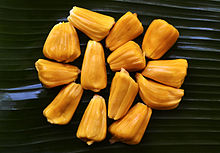By CHIA JOO SUAN
JACKFRUIT, which is rich in minerals and vision nutrients, is well known for its sweet and aromatic orange-yellow pulps embedded in a big fruit.
The ripe unopened jackfruit is green and thorny. It has a strong disagreeable odour to some, like that of decayed onions. Amazingly, the pulps within have a rich flavour, which is somewhat like pineapple, mango and banana mixed together.
| ||
There may be 100 or up to 500 fruit pulps in a single jackfruit. The fruit is known as nangka in Malaysia, jak in the Philippines, khanun in Thailand, khnor in Cambodia, mak in Laos and mit in Vietnam.
Malaysia has two common varieties of jackfruit. The sweet but soft mushy and fibrous cempedak is smaller and is usually served deep-fried in flour batter or eaten fresh. Nangka is the more popular variety with crunchy pulps when eaten fresh.
Rich in minerals
Nangka nourishes with easily-absorbed minerals. The amount of calcium in 100g of nangka is about that in seven medium-sized apples. Magnesium that aids in building bones is also abundant. Magnesium acts as a natural muscles relaxant and keeps the blood circulating smoothly.
 Furthermore, 100g of nangka supply us with potassium equivalent to that of three apples. When we exercise, potassium plays an important role in maintaining proper function of our muscles and nerves. Eating food that contains potassium also reduces the risk of high-blood pressure.
Furthermore, 100g of nangka supply us with potassium equivalent to that of three apples. When we exercise, potassium plays an important role in maintaining proper function of our muscles and nerves. Eating food that contains potassium also reduces the risk of high-blood pressure.Nangka supports health with zinc that is required to transport vitamin A to the eyes for better vision. In addition, zinc affects our sense of taste, aids in wound healing and sperm production.
Nangka is a good source of manganese that is lacking in many fruits. The amount of manganese in 100g of nangka is about four times that of an orange or apple. After having a good meal, the fat, protein and carbohydrates are effectively broken down for energy production with the help of manganese. Furthermore, manganese is an important component of the enzyme superoxide dismutase that protects cell damage from free radicals.
Beyond energy production
Riboflavin (vitamin B2) protects cells from oxygen damage and supports cellular energy production. People who are sensitive to light often suffer soreness around the mouth or tearing in the eyes and they have deficiency in vitamin B2. Nangka is a good source of vitamin B2.
Nangka further supports heart health with vitamin B6. The combination of vitamin B2 and B6 is important in cardiovascular protection. Both vitamins function synergistically in breaking down homocysteine and maintaining healthy blood vessels. Vitamin B3, also known as niacin, may help us overcome muscular weakness.
Vision nutrients
 Vitamin A and related carotenoids are nutrients that contribute to the attractive colour of nangka. More importantly, these are vision nutrients which help us see better and reduce the risk of developing cataracts and other eye problems. In addition, taking food that contains high levels of the carotenoid beta-carotene are less likely to be affected by certain types of cancer, heart disease or stroke.
Vitamin A and related carotenoids are nutrients that contribute to the attractive colour of nangka. More importantly, these are vision nutrients which help us see better and reduce the risk of developing cataracts and other eye problems. In addition, taking food that contains high levels of the carotenoid beta-carotene are less likely to be affected by certain types of cancer, heart disease or stroke.Similar to orange, nangka contains cryptoxanthin, an orange-red carotenoid pigment that may lower the risk of developing lung cancer.
The amount of dietary fibre in 100g nangka is about one-third that of an orange. Dietary fibre supports bowel regularity and helps maintain cholesterol and blood sugar levels as well.
Just like the papaya, the amino acids in nangka are mainly aspartic acid, glutamic acid, alanine, glycine, valine, leucine, lysine and serine.
Amino acids are for energy metabolism, cell growth and repair of muscle tissue. They also function in antibody synthesis, breakdown of sugar that keeps us alert and for maintaining good skin complexion.
Safety
Pectin is a nutrient responsible for its laxative property that helps our bowel movements. Nangka, especially in the perigones or rags (the narrow ribbon-like fleshy strips that cover the fruit-lets) that we normally do not eat, but can be used in cooking, contains pectin and the enzyme pectinsterase.
When storing nangka, always keep the pulp dry. Water will activate the enzymes and soften the texture of the fruit. Chilling improves its flavour and makes it crispier.
All parts of the plant have a sticky white latex that contains artostenone. Coat the knife with a layer of oil when cutting the fruit to avoid messy handling.
Traditional use
The Chinese consider nangka a nutritious tonic. The seed is useful in overcoming the influence of alcohol. Roasted seeds are regarded as an aphrodisiac.
The ashes of nangka leaves, corn and coconut shells are mixed in oil for healing ulcers. The dried latex mixed with vinegar can be applied on abscesses and for snakebite. An extract of the root is taken in cases of fever and diarrhoea.
http://thestar.com.my/lifestyle/story.asp?file=/2004/6/2/features/8077527&sec=features